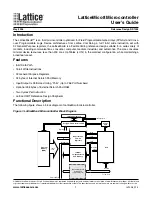MPC5553/MPC5554 Microcontroller Reference Manual, Rev. 5
22-28
Freescale Semiconductor
22.4.5.4
Protocol Timing
The clock source to the CAN protocol interface (CPI) can be either the system clock or a direct feed from
the oscillator pin EXTAL. The clock source is selected by the CLK_SRC bit in the CAN_CR. The clock
is fed to the prescaler to generate the serial clock (SCK).
The FlexCAN2 module supports a variety of means to setup bit timing parameters that are required by the
CAN protocol. The CAN
x
_CR has various fields used to control bit timing parameters: PRESDIV,
PROPSEG, PSEG1, PSEG2 and RJW. See
Section 22.3.3.2, “Control Register (CANx_CR)
.”
The PRESDIV field controls a prescaler that generates the serial clock (SCK), whose period defines the
‘time quantum’ used to compose the CAN waveform. A time quantum is the atomic unit of time handled
by FlexCAN.
A bit time is subdivided into three segments
1
):
•
SYNCSEG: This segment has a fixed length of one time quantum. Signal edges are expected to
happen within this section.
•
Time segment 1: This segment includes the propagation segment and the phase segment 1 of the
CAN standard. It can be programmed by setting the PROPSEG and the PSEG1 fields of the CTRL
register so that their sum (plus 2) is in the range of 4 to 16 time quanta.
•
Time segment 2: This segment represents the phase segment 2 of the CAN standard. It can be
programmed by setting the PSEG2 field of the CTRL register (plus 1) to be 2 to 8 time quanta long.
Figure 22-13. Segments within the Bit Time
1. For further explanation of the underlying concepts please refer to ISO/DIS 11519–1, Section 10.3. Reference also the Bosch
CAN 2.0A/B protocol specification dated September 1991 for bit timing.
f
Tq
f
CANCLK
Prescaler Value
------------------------------------------
=
Bit Rate
f
Tq
Number of Time Quanta
---------------------------------------------------------------------
=
SYNCSEG
Time Segment 1
Time Segment 2
1
4 ... 16
2 ... 8
8 ... 25 Time Quanta
= 1 Bit Time
NRZ Signal
Sample Point
(single or triple sampling)
(P PSEG1 + 2)
(PSEG2 + 1)
Transmit Point
Summary of Contents for MPC5553
Page 5: ...MPC5553 MPC5554 Microcontroller Reference Manual Rev 5 2 Freescale Semiconductor...
Page 21: ...MPC5553 MPC5554 Microcontroller Reference Manual Rev 5 xvi Freescale Semiconductor...
Page 47: ...MPC5553 MPC5554 Microcontroller Reference Manual Rev 5 1 26 Freescale Semiconductor...
Page 163: ...MPC5553 MPC5554 Microcontroller Reference Manual Rev 5 4 20 Freescale Semiconductor...
Page 179: ...MPC5553 MPC5554 Microcontroller Reference Manual Rev 5 5 16 Freescale Semiconductor...
Page 561: ...MPC5553 MPC5554 Microcontroller Reference Manual Rev 5 13 38 Freescale Semiconductor...
Page 615: ...MPC5553 MPC5554 Microcontroller Reference Manual Rev 5 14 54 Freescale Semiconductor...
Page 707: ...MPC5553 MPC5554 Microcontroller Reference Manual Rev 5 17 68 Freescale Semiconductor...
Page 755: ...MPC5553 MPC5554 Microcontroller Reference Manual Rev 5 18 48 Freescale Semiconductor...
Page 873: ...MPC5553 MPC5554 Microcontroller Reference Manual Rev 5 19 118 Freescale Semiconductor...
Page 984: ...MPC5553 MPC5554 Microcontroller Reference Manual Rev 5 Freescale Semiconductor 21 41...
Page 985: ...MPC5553 MPC5554 Microcontroller Reference Manual Rev 5 21 42 Freescale Semiconductor...
Page 1019: ...MPC5553 MPC5554 Microcontroller Reference Manual Rev 5 22 34 Freescale Semiconductor...
Page 1129: ...MPC5553 MPC5554 Microcontroller Reference Manual Rev 5 25 90 Freescale Semiconductor...


















